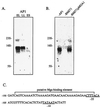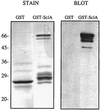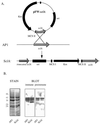SclA, a novel collagen-like surface protein of Streptococcus pyogenes
- PMID: 11035747
- PMCID: PMC97721
- DOI: 10.1128/IAI.68.11.6370-6377.2000
SclA, a novel collagen-like surface protein of Streptococcus pyogenes
Abstract
Surface proteins of Streptococcus pyogenes are important virulence factors. Here we describe a novel collagen-like surface protein, designated SclA (streptococcal collagen-like surface protein). The sclA gene was identified in silico using the Streptococcal Genome Sequencing Project with the recently identified protein GRAB as the probe. SclA has a signal sequence and a cell wall attachment region containing the prototypic LPXTGX motif. The surface-exposed part of SclA contains a unique NH(2)-terminal domain of 73 amino acids, followed by a collagen-like region. The sclA gene was found to be positively regulated by Mga, a transcriptional activator of several S. pyogenes virulence determinants. A mutant lacking cell wall-associated SclA was constructed and was found to be as effective as wild-type bacteria in platelet aggregation, survival in fresh human blood, and adherence to pharyngeal cells. The sclA gene was found in all 12 S. pyogenes strains that were investigated using PCR. Sequence analysis revealed that the signal sequence and the cell wall attachment region are highly conserved. The collagen-like domain is variable in its NH(2)-terminal region and has conserved repeated domains in its COOH-terminal part. SclA proteins from most strains have additional proline-rich repeats spacing the collagen-like domain and the cell wall attachment sequence. The unique NH(2)-terminal region is hypervariable, but computer predictions indicate a common secondary structure, with two alpha helices connected by a loop region. Immune selection may explain the hypervariability in the NH(2)-terminal region, whereas the preserved secondary structure implies that this region has a common function. These features and the Mga regulation are shared with the M protein of S. pyogenes. Moreover, as with the gene encoding the M protein, phylogenetic analysis indicates that horizontal gene transfer has contributed to the evolution of sclA.
Figures





References
-
- Åkesson P, Cooney J, Kishimoto F, Björck L. Protein H—a novel IgG binding bacterial protein. Mol Immunol. 1990;6:523–531. - PubMed
-
- Åkesson P, Sjöholm A G, Björck L. Protein SIC, a novel extracellular protein of Streptococcus pyogenes interfering with complement function. J Biol Chem. 1996;271:1081–1088. - PubMed
-
- Berge A, Sjöbring U. PAM, a novel plasminogen-binding protein from Streptococcus pyogenes. J Biol Chem. 1993;268:25417–25424. - PubMed
Publication types
MeSH terms
Substances
Associated data
- Actions
- Actions
- Actions
- Actions
- Actions
- Actions
- Actions
- Actions
- Actions
- Actions
- Actions
- Actions
LinkOut - more resources
Full Text Sources
Other Literature Sources
Molecular Biology Databases
